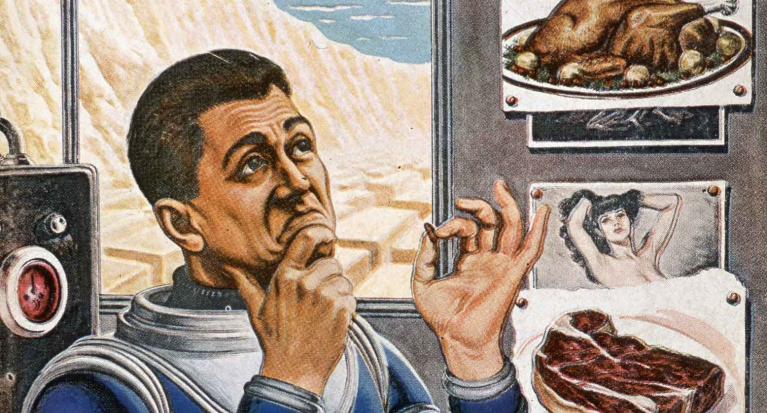Ötzi and his diet
Mummies and skeletons reveal early eating habits.
The new reconstruction of the Iceman as presented in the South Tyrolean Archaeology Museum showing the Iceman with brown eyes based on the genetic analysis.
© Ochsenreiter/South Tyrol Museum of Archaeology
Once we had to rely on associated finds during archaeological digs to reconstruct the diet of our ancestors in pre- and early history. These finds, uncovered while excavating settlements and burial grounds, include fragments of animal bones, seashells and fish bones, as well as plant substances such as grains, nuts and seeds. They allow us to infer the ingredients and variety of the food consumed by a specific population. Yet such finds often just reflect the general nutritional situation; they do not allow us to study individual eating habits and so discover possible variations within a community.
In human development, brain growth would not have been so rapid without the consumption of meat.
The reconstruction of diets plays an important role in studies of pre- and early historical populations. On the one hand, it provides insight into the types of food consumed and their composition; on the other, regional differences between contemporary populations can be identified. Such differences result from divergent environmental or geographical conditions. Hence we would expect a higher proportion of fish and seafood in the diet of populations living, for instance, at the coast or near rivers or lakes, and a higher proportion of meat and grains in the diet of those who settled in inland regions. It is also possible to detect eating habits that have changed over time and the differences between the social strata and other groups.
New research methods
Thanks to new methods of analysis, it has become possible in recent decades to investigate human remains much more directly. Isotope analysis of bone tissue is now an especially effective method for determining individual eating habits. It allows a direct look at how people nourished themselves: we can see if a person was more of a herbivore or an omnivore and if they ate meat or preferred marine or freshwater fish and shellfish.
With the aid of isotope analysis, scientists have, for example, determined that Neanderthals mainly ate meat, an indication that hunting was an important means of survival. Early hunters apparently favoured large mammals such as horses and cows, and were less interested in smaller animals. The results of bone analyses from several Neanderthals are similar to those obtained from animal carnivores.
It is generally assumed that the rise in the consumption of meat crucially affected human evolution. The enormous brain growth in humans would not have been possible to the extent seen without an increase in the intake of high-energy and high-quality animal fats and proteins: in comparison to body mass, our brains are disproportionately large and require much energy. This development was accelerated by the use of fire in preparing food; cooked foods are easier to digest.
And yet plant foods also played a role in the diet of humans in pre- and early history. Berries, mushrooms, fruits and roots were vital nutritional supplements. Finds such as nutshells and carbonized fruits at early historical sites substantiate this fact. Moreover, investigation of human teeth and the tartar on them has shown that plants with their medicinal qualities were an important factor in the overall diet of early humans and Neanderthals.
Mummies provide new insights
The scientific examination of mummies provides another way to reconstruct the diets of early peoples. In mummies, not just the bones are preserved but also soft tissues and organs, sometimes even parts of the digestive tract or stomach and intestinal contents. In this context, a particularly impressive specimen is the mummy of a 5300-year-old corpse that was preserved by a glacier and is known worldwide today by the nickname “Ötzi” or the “Iceman”.
The study of Ötzi’s corpse began with isotope analyses. The initial results indicated that the Iceman was primarily a vegetarian or even a vegan. This appeared to refute the view that in the late Neolithic Period (New Stone Age) and in the Chalcolithic Period (Copper Age), the hunting of meat, and hence its consumption, was still a major dietary factor. This view is supported by the bones and antlers of wild animals found during archaeological excavations of settlements from this period, as well as by the Iceman’s own hunting equipment – a bow and arrows.
The stomach of the Iceman is well preserved and completely filled (arrows).
© Department of Radiodiagnostics, Central Hospital Bozen/Bolzano
More recent analysis of Ötzi’s stomach and intestines has resolved this contradiction: the contents of his intestines have revealed fragments of bones from an ibex, alongside various remains of plant origin. A detailed genetic analysis of his intestinal contents also showed that he had consumed venison. The latest study conducted on his stomach contents revealed that his last meal consisted largely of ibex and venison with a high percentage of fat. Studies have also shown that the Iceman – and, indeed, the entire population of present-day South Tyrol – had a very balanced diet. Early types of grain – such as einkorn and emmer – were probably consumed in the form of porridge or bread. The diet also included a large number of other plant products, including various vegetables, fruits and wild berries, as well as dried wild fruits.
From hunter to farmer
The transition from life as hunter and gatherer to the production of food and thus farming, was a decisive turning point in the history of civilisation. Twelve thousand years ago, in what is today southeast Turkey, nomadic life turned more sedentary with the emergence of crop and animal husbandry. Over the next millennium of the Neolithic Period, this sedentary way of life spread from the region of the Fertile Crescent across Europe (hence the term “Neolithic Revolution”).
The exact reasons for the success and rapid expansion of this new mode of life are still disputed. An important factor was the fast growth of the population and the greater demand for food. With the cultivation of crops, more grain could be produced; at the same time, the size and number of grain kernels increased. Wild animals were still an important source of food, but over time shortages forced people to breed animals as well. The domestication of wild animals allowed people to use them more exhaustively – they were kept as work animals, and provided their keepers with skins and wool as well as meat.
As time progressed, protein and high-fat milk and cheese products became an ever more important food source. Initially milk must have played a minor role in people’s diets, as it took hundreds of years before an adolescent or adult body in Europe was able to tolerate milk. Genetic analyses of the Iceman and other skeletons have revealed that the majority of European people were still lactose intolerant in the Neolithic Period, which meant that after they stopped nursing they were unable to digest the sugar in milk.
These investigations of pre- and early historical diets compellingly show the interrelationship between nutritional strategies, successful development and the spread of humankind.
DOSSIER Trends and Turns |
| Canned food – an instrument of power | |
| The rise of the Mediterranean diet | |
| Ötzi and his diet | |
| Too much or not enough? | |
| It may look good, but is it? | |
| The perfect meal in a pill? | |
| All dossiers | |
Interview with Dr. Albert Zink
The Fertile Crescent
The region of the Fertile Crescent is considered a cradle of the Neolithic Revolution: it was here that the transition from hunting and foraging to crop and animal husbandry began around 8000 B.C. Some of the oldest urban civilisations in the world developed in this region.
Read more on wikipedia




